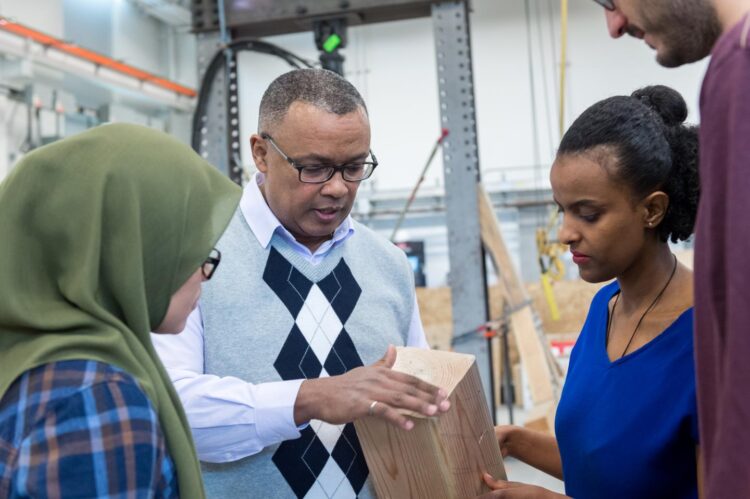Tall mass-timber buildings are a safe and sustainable alternative for high-rise construction

Credit: UBC Okanagan
With an increasing demand for a more sustainable alternative for high-rise construction, new research from UBC Okanagan, in collaboration with Western University and FPInnovations, points to timber as a sustainable and effective way to make tall, high-density, and renewable buildings.
“Many people have trouble imagining a timber high-rise of up to 40 storeys when we’re so used to seeing concrete and steel being the norm in today’s construction,” explains Matiyas Bezabeh, a doctoral candidate at the UBCO School of Engineering. “But we’re starting to demonstrate that the proverbial wolf can’t knock over the pig’s wooden building when they’re built using modern techniques.”
Bezabeh and his supervisors, Professors Solomon Tesfamariam from UBC Okanagan and Girma Bitsuamlak from Western University, conducted extensive wind testing on tall mass-timber buildings of varying height between 10 and 40-storeys at Western University’s Boundary Layer Wind Tunnel Laboratory.
“We found that the studied buildings up to 20-storeys, using today’s building codes, can withstand high-wind events,” says Bezabeh. “However, in the cases we studied, once we get up to 30 and 40 storeys, aerodynamic and structural improvements would be needed to address excessive wind-induced motion–something that would impact the comfort of those inside.
In 2020, the National Building Code of Canada doubled the height allowance of timber buildings from six storeys to twelve. The 2021 edition of the International Building Code (IBC) will include provisions to allow mass-timber buildings up to 18-stories.
“What’s exciting about our findings is that while additional engineering is required for these taller timber buildings, the problems are absolutely solvable, which opens the door to new architectural possibilities,” adds Tesfamariam. “And with a shift towards sustainable urbanization across North America and Europe, the use of timber as a structural material addresses both the issues of sustainability and renewability of resources.”
Tesfamariam, an engineering professor at UBCO, also sits on the Systems Design and Connections Subcommittee of the Canadian Wood Council, which is responsible for setting building code and engineering standards nationally.
According to Bezabeh, there is a growing acceptance of using mass-timber products such as cross-laminated timber because of its higher strength-to-weight ratio, aesthetics, and construction efficiency.
“We hope our research will continue the design and structural innovation in this area and perhaps one day soon many of us will be living in mass-timber high-rise apartments.”
The School of Engineering offers a new course in advanced design of timber structures, led by Tesfamariam, geared for students and industry professionals interested in understanding timber products, design of timber structural elements, the fundaments of structural dynamics for timber buildings, and the design of low-, mid- and high-rise timber and timber-hybrid buildings.
###
The research is published in the Journal of Structural Engineering.
Media Contact
Nathan Skolski
[email protected]
Original Source
https:/
Related Journal Article
http://dx.





